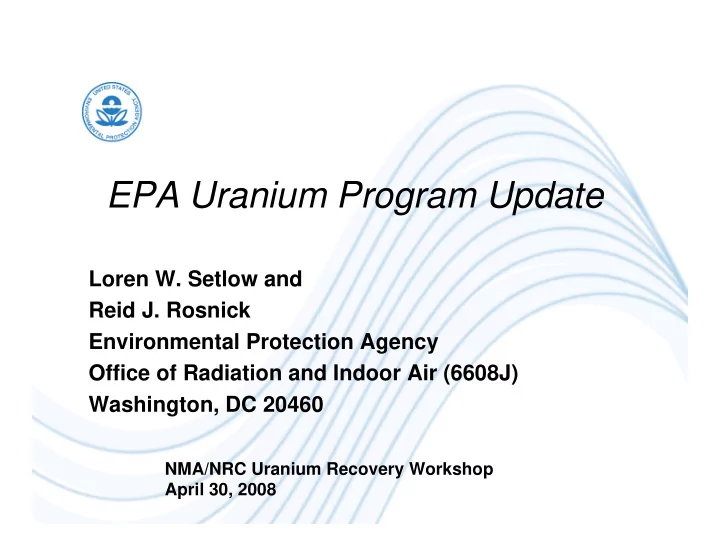

EPA Uranium Program Update Loren W. Setlow and Reid J. Rosnick Environmental Protection Agency Office of Radiation and Indoor Air (6608J) Washington, DC 20460 NMA/NRC Uranium Recovery Workshop April 30, 2008
Overview � EPA Radiation protection program � Uranium reports and abandoned mine lands program � Coordination with NRC rulemaking � EPA regulatory requirements for uranium operations 2
EPA Radiation Protection Program • Specific Atomic Energy Act radiation protection authorities and responsibilities assigned to EPA under Reorganization Plan No. 3 in 1970; • and • Environmental statute authorities; examples applicable to uranium extraction include • Uranium Mill Tailings Radiation Control Act • Clean Air Act • Clean Water Act • Safe Drinking Water Act • Comprehensive Environmental Response, Compensation and Liability Act 3
Uranium Reports and Abandoned Mine Lands Program • Technologically Enhanced Naturally Occurring Radioactive Materials from Uranium Mining, Volume I: Mining and Reclamation Background (Revised June 2007) • Volume II: Investigation of Potential Health, Geographic and Environmental Issues From Abandoned Uranium Mines ( Final released April 2008) • Uranium Location Database (August 2006) • Compilation of Federal and State sources, ~15,000 records • Digital GIS database product 4
Uranium Reports and Abandoned Mine Lands Program • Uranium AML Program: • Continued to partner with Federal Mining Dialogue agencies; uranium location database incorporated into combined AML spatial database • Agency testimony for House Hearing on Navajo uranium AML-Oct. 2007, Senate Hearing on AML and uranium mining-March 2008 • EPA assistance to Navajo Nation—Five year plan to address uranium contamination 5
EPA Coordination with NRC Rulemaking • EPA policy on ISL groundwater protection: • EPA regulations generated in accordance with UMTRCA (40 CFR 192) provide the appropriate standards to be used by NRC for groundwater protection • EPA’s UIC regulations promulgated under the Safe Drinking Water Act (40 CFR 146) provide standards which must be followed by ISL injection well applicants, but are supplemental and independent of the requirements developed under UMTRCA 6
EPA Coordination with NRC Rulemaking • During 2007 and 2008, EPA participated on NRC Working Group to develop draft proposed uranium ISL groundwater protection rule • EPA participation is to ensure that NRC incorporates EPA regulatory requirements developed under UMTRCA and that are consistent with EPA UIC injection well regulations • Under UMTRCA, NRC must obtain EPA concurrence on the rule 7
EPA Regulatory Requirements For Uranium Operations (UMTRCA) • 40 CFR 192 regulations implementing UMTRCA for environmental and radiation protection at uranium mills and uranium extraction facilities, adopted by NRC in 10 CFR Part 40 • Under UMTRCA (and RCRA), restoration of groundwater must be to • (1) background; or • (2) Maximum Concentration Limits (MCL’s) for particular constituents, whichever is higher; or • (3) Alternate Concentration Limits (ACLs), if established 8
EPA Regulatory Requirements For Uranium Operations (UMTRCA) • ACLs must be determined on a case-by-case basis and meet ALARA. • Class of use is not an approved provision under UMTRCA/RCRA for meeting ACL’s and ALARA • Class of use could be considered as one input in determining final ACLs • Radiation and environmental protection standards for surface facilities and impoundments also established in 40 CFR 192 9
EPA Regulatory Requirements For Uranium Operations (SDWA-UIC; CWA) • EPA’s UIC regulations promulgated under the Safe Drinking Water Act (40 CFR 144 and 146) provide standards which must be followed by ISL injection well applicants • UIC Class III injection wells • UIC Class V disposal wells • 40 CFR 440 Subpart C implementing the Clean Water Act with requirements for environmental limitations on discharges from uranium, vanadium and radium mines, mills and ISL facilities 10
EPA Regulatory Requirements for Uranium Operations (Clean Air Act) • 40 CFR 61, Subpart B regulations limiting radon emissions from underground uranium mines include: • Applies to 10,000 tons/yr ore production, or 100,000 tons/mine lifetime • Ambient air radon standard not to exceed 10 mrem/yr to any member of the public-compliance determined with COMPLY-R, or equivalent, approved code • Annual reporting requirements – by 3/31 each year, emissions calculations for the year, monthly if not in compliance • Record keeping requirements: Five years 11
EPA Regulatory Requirements for Uranium Operations (Clean Air Act) • 40 CFR 61 Subpart W Requirements apply to facilities licensed to manage uranium byproduct materials (after 12/15/89) during and following the processing of uranium ores • Preconstruction approval, 40 CFR 61.07 • Impoundment construction and operation requirements in 40 CFR 192 cross referenced in Subpart W • Limit on number/size of impoundments • Phased Disposal – lined impoundments no more than 40 acres, no more than two in operation at any time • Continuous Disposal – tailings are dewatered and immediately disposed, no more than 10 acres uncovered at any time 12
EPA Regulatory Requirements for Uranium Operations (Clean Air Act) Subpart W Requirements (continued) • What is an impoundment (per 40 CFR 192.32, which cross references 40 CFR 260.10)? • “…a facility or part of a facility which is a natural topographic depression, man-made excavation or diked area formed primarily of earthen materials (although it may be lined with man-made materials) which is designed to hold an accumulation of liquid wastes, or wastes containing free liquids, and which is not an injection well. Examples of impoundments are holding, storage, settling, and aeration pits, ponds and lagoons.” 13
EPA Regulatory Requirements for Uranium Operations (Clean Air Act) Subpart W Requirements (continued) • Radon emission standard of 20 pCi/m 2 /sec -- annual reporting requirements, notification in advance of testing • The radon emission standard is for existing sources only (existing before 12/15/89) • All operators must comply with 40 CFR 192.32(a), Application standards for processing operations, and prior to end of the closure period. • See http://www.epa.gov/radiation/neshaps/subpartw/ index.html for more information 14
15 Questions?
Recommend
More recommend